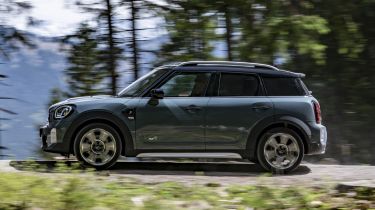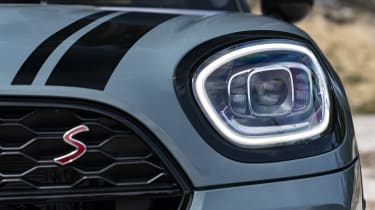MINI Countryman SUV (2016–2023) - Engines, drive & performance
The MINI Countryman isn’t as nimble as the hatchback, but it’s still fun to drive
From the day the original Mini arrived in 1959, a fantastic driving experience has been guaranteed - even in the newer, larger models. By and large, today’s MINIs stay true to the responsive, nimble feel of the original, and given its considerable bulk, the latest Countryman acquits itself well, meeting the demands of relaxed and determined drivers alike.
It also shrinks around you and when the road opens up, you feel like you’re behind the wheel of something small and sporty. The steering is accurate, with just enough weight for the driver to feel involved, but on a really challenging road, you're reminded the Countryman is rather a heavy car, lacking the dart-like responsiveness of the MINI hatchback. It’s still better than cars such as the Nissan Qashqai or Peugeot 2008 in this respect.
There’s an optional Dynamic Damper Control available, allowing you to adjust the softness of the suspension and enabling further personalisation of the (also optional) MINI Driving Modes. This lets you choose how sensitive the accelerator is and how much power assistance is given to the steering, for a more on-edge driving experience if desired.
If you push really hard, you’ll feel the body leaning a little in corners, but you’re unlikely to run short of grip – especially in cars with the ALL4 four-wheel-drive system. This usually sends power to the front wheels, with drive to the rear being engaged automatically when computers sense it’s necessary. You can also manually engage power to all wheels yourself.
More reviews
The extra weight of the Countryman Plug-In Hybrid is considerable – those batteries and the electric motor add 130kg to a regular Cooper S. In some ways it actually helps, though, as the steering feels a little less twitchy while agility remains largely intact. On other models, though, we’re less sure ALL4 is an option worth having. The Countryman isn’t really suitable for off-road driving and while the system does improve traction on the road, the front-wheel drive car is fine in most situations and cheaper to run.
We’re more impressed by the Countryman’s ride quality. The suspension isn’t soft – you can still clearly feel potholes as you pass over them slowly at urban speeds – but the ride becomes smoother as the car gathers speed. Motorway miles pass in an unruffled, relaxed manner in keeping with the more mature feel we mentioned earlier.
Unfortunately, ride quality is one factor where the Countryman Plug-In Hybrid does lose out compared to other models in the range – its suspension has been stiffened to cope with the extra weight and you feel the difference over bumps.
MINI Countryman petrol engines
The entry-level Cooper Countryman has a 1.5-litre turbocharged petrol engine that emits a pleasingly rorty exhaust note on acceleration. Its 136bhp is enough to whisk it to 62mph from rest in 9.7 seconds, so it doesn’t feel sluggish, although its substantial 1,365kg weight puts it at a disadvantage compared to some smaller-engined rivals.
It's also somewhat overshadowed by the 2.0-litre, four-cylinder turbocharged engine of the Cooper S. With 176bhp, it enables a 0-62mph time of just 7.5 seconds. It doesn’t feel quite as fast as the MINI Cooper S hatchback, though. Enthusiastic drivers will enjoy the sporty noises the Cooper S exhaust makes, particularly when Sports mode is engaged through the dynamic drive menu.
This can adjust mechanical settings for a more involving driving experience and is very effective, although it can’t overcome the physical limitations of the Countryman’s considerable weight.
While likely to remain something of a rarity, there's also a MINI Countryman John Cooper Works with a huge 302bhp and four-wheel drive. This enables it to leap from 0-62mph in just 5.1 seconds, rivalling performance crossovers like the Audi SQ2 and Volkswagen T-Roc R for pace.
Diesel engines
From early 2020, the Cooper D Clubman's 2.0-litre diesel engine was discontinued due to falling demand. When it was on sale, it could be specced with front-wheel drive or ALL4 four-wheel drive, managing a 0-62mph time of 9.1 seconds.
Hybrid engines
The Countryman Plug-In Hybrid uses the same combination of a 1.5-litre petrol engine and electric motor as the BMW 2 Series Active Tourer hybrid. Working together, the pairing adds up to 217bhp, which is enough for a 0-62mph time of 6.8 seconds – faster than the regular Cooper S. Its immediate get-up-and-go is largely thanks to being four-wheel drive, but unlike other ALL4 models, the petrol engine powers the front wheels and the electric motor takes care of the rears.
When driving in all-electric mode – the 87bhp electric motor can get you to 78mph alone – the Plug-In Hybrid is effectively a rear-wheel-drive car, although you don’t really notice the difference. The impressive top speed when running on electric power means you never feel short of power in the urban areas where such cars excel. In fact, if you’re travelling under 40mph, power is so plentiful that it takes a really hard kick on the accelerator to wake the petrol engine.
The all-electric performance feels spirited up to 60mph, but beyond that you really do need the petrol engine if momentum is to be maintained. Unfortunately, once the all-electric range is depleted, or when tackling roads that hybrid mode doesn’t suit, the batteries and electric motor are turned into heavy, economy-sapping extra baggage.













